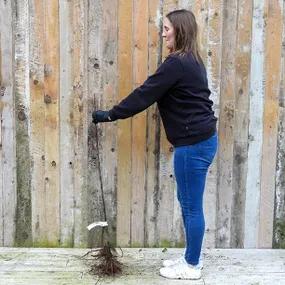Reverend W Wilks Apple Trees
Honest Delivery Prices- Height: to 4m
- Use: Cooking
- Pruning: Spur bearer
- Pollination: Self Fertile
- Picking: late August
- Apple colour: Yellow/Green
- Pollination Group: Group B
Recommended extras
Description
Reverend W Wilks Cooking Apples
One of the Reverend W Wilks' real blessings is that it is a cooking apple that is slightly premature and so is ready to use when blackberries are ripe. Other virtues include a very large, striking green apple with bright white flesh, a good sharp flavour and reasonable resistance to all the sins of apple trees like canker, scab and mildew. As befits a clergy man, the blossom is whiter than white, early and all-encompassing. Indeed, this tree is often grown purely for this attribute making it a member of a broad church, equally at home in both garden and orchard. The apples when cooked repent into a pool of excellent purée. The only cross to bear with this apple tree is that it is not very vigorous however this makes it possible to grow even in small gardens.
Browse our full range of apple trees for sale or see the full variety of fruit trees available online.
A parish for Reverend Wilks
Being productive, compact and beautiful makes this a highly desirable apple tree. It kicks off the bounty of autumn and is easy to grow. Consider it as the centrepiece of a white garden and you would not be disappointed. Partner it with another self fertile to reap maximum apple reward. A larger garden might accommodate a couple of eaters like Greensleeves and Red Falstaff which would span the season and look good too. You could think about trailing some climbing roses through the branches of your trees: another white one, or you could shock the Reverend with the bright pink Dancing Queen.
Features
- Height: Bushes to 3 metres and half standards to a touch over 4 metres
- Use: Cooking
- Pruning: Spur bearer
- Pollination: Self Fertile
- Picking: late August - November
- Apple colour: Yellow/Green
- Pollination Group: Group B
- Storage: 1-2 weeks
Who was Reverend W Wilks?
The fact that this apple tree was named after the then President of the RHS demonstrates the importance attached to cooking apple trees in Victorian times. It was raised by Mr Veitch in Chelsea, London in 1904 and given its RHS Award of Merit the same year. It is thought that the wonderfully named Peasgood Nonsuch and Ribston Pippin are the Rev's parents. A pippin is an old term for a sapling. Often new apple trees came about by happenstance and people would literally find a seedling in an orchard and look after it to see what fruit it might bear.

 1.webp)
 1.webp)

